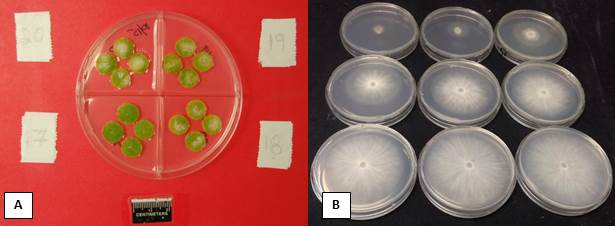
The 2013 foliar peanut disease fungicide trial from Marianna, FL. It is important to monitor products for reductions in their efficacy when managing for fungicide resistance.
Early in 2014 the patent for the popular strobilurin fungicide (FRAC group 11) azoxystrobin will expire. Azoxystrobin is the active ingredient in the Syngenta® fungicides Quadris®, Abound® and Heritage® as well as a component of many other premixes (e.g. Quadris Top® and Quilt®). There have been press releases indicating that the fungicide companies MANA and Cheminova will be releasing products containing azoxystrobin in 2014. As these new products are released into the market, understanding their active ingredients and mode of action will be important to prolonging their effectiveness.
The Fungicide Resistance Action Committee (FRAC) developed a letter and number system that can be used to determine how a fungicide works based on their mode of action and active ingredient. This FRAC code can be found on every fungicide label and more information about this subject is available at EDIS. Because resistance to azoxystrobin has already been reported in multiple pathogens, it is critical that we maintain proper stewardship of this fungicide. A fungus exhibiting resistance to a specific fungicide may also be resistant to many or all of the fungicides with the same FRAC code. Proper fungicide rotation will help reduce the selection pressure placed on a single pathogen population.
Tank mixing fungicides or using premixes, products with two or more fungicides, will also aid in fungicide resistance management. This helps reduce selection pressure because if a fungus develops resistance to one fungicide, it will be killed or limited by the other fungicide in the mix. However, this only works when the mixed fungicides both actively manage the fungal pest of interest. In general, it is good to not apply more than two sequential applications of a specific product and to add protective multisite fungicides (e.g. chlorothalonil and mancozeb) to the spray program when appropriate. It is critical that a fungicide is applied only when necessary.
Two other guidelines that can help reduce the development of fungicide resistance are maintaining healthy crops and monitoring product efficacy. Healthy crops are often less susceptible to fungal diseases and thus can reduce the need for a fungicide application. When a fungicide is applied, it is useful to monitor the efficacy of that spray. Ineffective control by a fungicide labeled for a disease may indicate the development of a resistant population. It is important that users contact their local extension office about products exhibiting ineffective control so researchers can examine the isolates for resistance. The sooner a resistant population is identified the quicker programs can be adjusted to limit this problem.

Examples of fungicide sensitivity assays using different fungicide concentrations. These tests are used to determine fungicide resistance for (A) powdery mildew of cucurbits and (B) white mold/stem rot of peanuts.
So, what does this mean for 2014? It means that as the new generic azoxystrobin products are released, it will be important to monitor and plan how to use these fungicide products. It is likely that these products will fit into many spray programs and will provide effective control at a reduced cost. However, the overuse of these products can lead to the development of fungicide resistance, and lead to the loss of effective disease management tools. More general information about fungicides can be found in the book Fungicides for Field Crops available at APS Press, Amazon and online.
- Southern Rust Confirmed in the Florida Panhandle – June 2025 - June 6, 2025
- Stay Ahead of Disease with the Spore Report: A New Tool to Assist with Potato and Watermelon Management - April 11, 2025
- 2024 End-of-Season Florida Peanut Disease Notes - October 11, 2024
